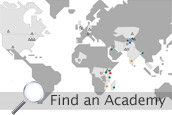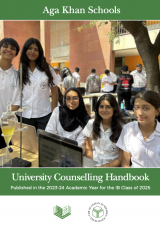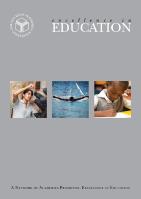Technology-meets-service initiative – through robots
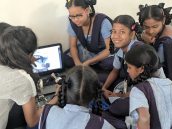
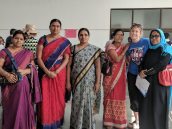
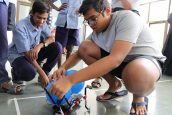
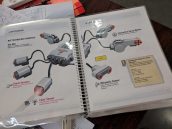
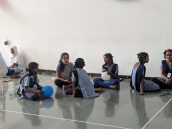
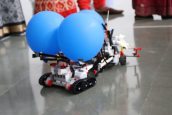
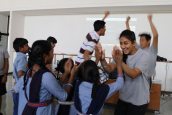
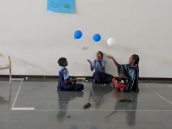

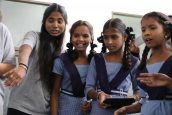
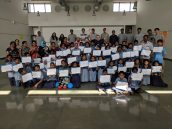
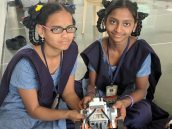
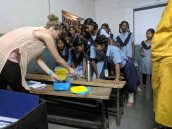
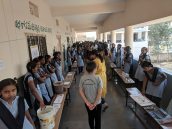 The Academy’s outreach department held a day-long robotics workshop and tournament for 48 grade 6 students from seven nearby government schools on Saturday 24thFebruary.
The Academy’s outreach department held a day-long robotics workshop and tournament for 48 grade 6 students from seven nearby government schools on Saturday 24thFebruary.
A truly cross-disciplinary and diverse integration technology-meets-service initiative made its debut on Saturday and carried on through the week. The collaboration involved a lot of people: grade 11 CAS students, grade 8-9 robotics enrichment club members, grade 8 service class, Diploma Programme students from last term’s competitive robotics team, volunteers from grade 9 and 10, and seven government schools all under the direction of CAS coordinator Venkat Reddy and Ontario technology teacher Michelle Massaro. Participating students from the government schools were identified by their teachers as having a keen interest in science and technology.
The grade 11 CAS students, under the leadership of Anish and Rudra, divided the 48 participating students into teams. They identified a mother tongue speaking student from their pool of Academy volunteers for each team as well as a student experienced in robotics to lead each team. They translated the curriculum we would use for the tournament, and all of relevant documents were put up on a website including the workshop schedule, robot build guides, tournament rules and feedback form. To keep the tournament fully paperless, Rudra set up an online score board to monitor the teams' progress through the tournament that was updated live throughout the latter half of the day.
Upon arrival, our logistics team registered students at the door to verify their names and schools and let them know which team they were in. They entered the workshop room – the student lounge – which had been segregated into “pit areas” designated for each team to work on their robot. Greeted by their team leaders and translator, the students got to work coming up with a team name and designing a poster together to break the ice. Then, it was time for the real learning – students underwent a crash course in the engineering design process with their teams and found out the answers to a lot of questions! What task do we need to accomplish? What are the parts of a robot? How do the parts connect? How do you control a robot? What is coding? How can we adjust our design to be stronger or faster? The students were all so engaged, both Academy and government, to the point we had to push them to even go eat their lunch at break time!
After lunch it was time for the teams to put their robots to the test! The tournament involved attaching two balloons to your robot which needed to be able to drive around an arena, controlled by the team’s robot driver using an iPad. Teams had to find a way using a needle on their robot to pop the balloons of the other bot in the arena during a head-to-head match. The tournament was double-elimination which made sure each team got to compete in at least two matches. Once eliminated, the students remained engaged because the head-to-head action along with Mr Venkat’s MC-ing and play-by-play skills in multiple languages kept everyone on their toes!
“It sounds like you guys are riding a roller coaster in there!” a student passing by the Commons exclaimed. The place was indeed buzzing with excitement, as students continued to strategise, modify and repair their robots in their pit areas with their team leaders between matches. After the finals were played, the wining team of grade 6s was declared, “the Sunrisers” from ZPHS Mamidipally who proceeded to surround and somehow hoist up their grade 11 team captain Anish in the air in celebration!
Then all of the teams crowded around the robot arena to watch the finale; the government teachers vs. the winning student team. The government teachers who accompanied their students had been able to form their own team led by grade 9 robotics students to learn and experience this new technology alongside their students. Needless to say, all the teams united to cheer on the winning student team as they took down their teachers 2-0!
Award certificates were presented to all participants, team photos were taken and feedback was collected. The teachers and students alike found the entire programme engaging and are very excited at the prospect of continuing this on an ongoing basis as part of STEAM (Science, Technology, Engineering Art & Mathematics) outreach opportunities offered by the CAS program at the Academy.
The first of the planned follow-ups to this introductory event took place on Wednesday 28th February which happened to be “National Science Day.” Academy grade 8 service students went out to visit the grade 6s they had mentored at the tournament from ZPHS Tukkuguda Girls’ school. They brought a robot that was donated to the school and presented the opportunity for the five students who took part in the workshop to teach the rest of their classmates the skills they had learned. The girls were thrilled and proud that they could become teachers themselves and share the experience with their peers. Our service students with the help of the workshop students introduced the robotics kit, the various parts and how to assemble and wire robots. They left the grade 6 class with the challenge to follow the instructions and work together to build a full robot by next week at which point they will return and begin to show them how to write a programme to control it. All involved are really excited about this continuing teaching-learning opportunity.
Sharing knowledge and providing access to high tech programs is a service opportunity that the students on both sides are benefitting from. As a teacher, it was incredibly rewarding to see our students in action displaying the passion and knowledge they had gained through the robotics programme taught at the Academy. In turn we got to take a step back as their teachers and help mentor them into the role as the CAS, robotics, and service students stepped up to help develop the workshop and tournament model and teach and lead the workshops, for younger inexperienced students would not have otherwise had the chance to explore this type of high-tech programming. Then the progression continued as these students have now taken a step back to empower the learners from their workshop to become mentors and pass on the knowledge to their classmates, spreading the knowledge further. This is an effort we can be so proud of at the Academy as we witness our students acting as true technology ambassadors!
Written by Michelle Massaro, Ontario seconded teacher at the Academy

